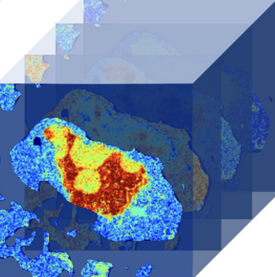francescociompi.com | 2025
GITHUB CODE
The following are public repositories developed in my team. Link to scientific publications are added when available.
Self-configuring framework to train a UNet segmentation model for digital pathology, based on the nnUnet framework, ported and optimised for
digital pathology by Joey Spronck in the context of the IGNITE project. [MIDL paper, 2023]
Python package to handle whole-slide images, read (using multiple backends like OpenSlide, Pyvips, ASAP) and sample patches, read annotations (with support for QuPath, ASAP and others), write results, and much more. Developed by Mart van Rijthoven in the context of the EXAMODE project.
Incarnation of the HookNet framework for the detection of tertiary lymphoid structured in whole-slide images. Developed by Mart van Rijthoven in the context of the EXAMODE project. [Communication Medicine paper, 2023]
Fast version of the HoVerNet model, originally developed in the TIA group, optimised by Cristian Tommasino by replacing the HoVerNet architecture with a single UNet model, trained from HoVerNet via knowledge distillation, achieving comparable results but a model 3 times faster. [Paper accepted at IEEE ISBI 2024][preprint]
Segmentation model to identify the main sources of artefacts in whole-slide images, with support for H&E and immunohistochemistry. Initially developed by Gijs Smit and as part of the AI for Health project, extended and improved by Marina D'Amato as part of the BigPicture project. [Paper published at MIDL, 2021]
Combo of two algorithms developed in my group (one for multi-class tissue segmentation, one for for lymphocyte detection) and released publicly as the baseline method for the TIGER challenge that we organized in 2022.
Even before the rise of foundation models, we proposed a framework to detect (and retrieve) objects in whole-slide images by using few shot learning. A pre-trained model was used and "prompted" at test time with visual examples, to retrieve simlar objects in the slide and detect them with bounding boxes. [Paper in Proceedings of SPIE Medical Imaging, 2021]
Multi-resolution approach that implements a multi-branch U-Net model that can be trained to include information from multiple resolutions of a whole-slide image, to incorporate contextual information and fine-grained details to produce a segmentation output. Developed in my team by Mart van Rijthoven in response to the need to account for both invasive and in-situ lesions in breast cancer slides, as well as differentiate between ductal and lobular carcinoma, it has become a general-purpose framework used by several groups in the community, part of the TIGER baseline algorithm, and also of our recent work on automated quantification of Tertiary Lymphoid Structures in several solid tumors. Simply type "pip install hooknet", that's it! You can find some nice visual examples of segmentation outputs at this link.
Inspired by the famous "exposé" features, which optimally arranges windows on your screen, we developed an algorithm to "pack" multiple digital pathology whole-slide images together. Useful tool to create single inputs for weakly-supervised learning, to deal with multiple slides from the same block when using labels defined at block level, and also to save some (background) space in your packed image. Developed as part of the ExaMode project.
We pioneered the idea of compressing whole-slide images using neural networks, to reduce the size of the image while keeping relevant semantic information needed to solve downstream tasks, such as weakly-supervised image classification, or regression, or survival prediction, etc. Developed in my team by David Tellez, Neural Image Compression has been the first work on computational pathology to be published on the prestigious journal IEEE Transactions of Pattern Analysis and Machine Intelligence [original paper] [MIDL paper on survival prediction].
ALGORITHMS ON GRAND-CHALLENGE
The following are stand-alone algorithms, running on the grand-challenge.org platform in the form of applications, which we made publicly available to the scientific community to try out our models without having to run any code. Users can upload images via the user interface, or interact with algorithms via Python code using the grand-challenge API. Contact me if you have any questions: francesco.ciompi@radboudumc.nl



PDL1 QUANTIFICATION
NUCLEI DETECTION IN IHC
ENDO-AID: ENDOMETRIAL PIPELLE CLASSIFICATION
Cell quantification (detection and classification) in PDL1 of lung cancer and automated tumor proportion score. [algorithm] [paper]



ARTIFACT SEGMENTATION
HOOKNET-TLS
TIGER BASELINE
Segmentation of the main artefacts in whole-slide images for quality control in digital pathology. [algorithm] [paper] [video]
HookNet model to detect and segment tertiary lymphoid structures and their germinal centres. [algorithm] [code] [paper]
Tissue segmentation and lymphocyte detection in breast cancer slides, used as baseline for the TIGER challenge. [algorithm][challenge]



WSI PACKER
HOOKNET BREAST
NEURAL IMAGE COMPRESSION
Handy tool to combine multiple whole-slide images into a single "packed" one. [algorithm]
Compression of whole-slide images using neural networks to reduce their sheer size for downstream tasks like classification or retrieval [algorithm] [code] [paper]



LUNG TUMOR SEGMENTATION
COLON TISSUE SEGMENTATION
T-CELL DETECTION IN IHC
Detection of lung cancer via tumor segmentation. [algorithm]



PROACTING BIOMARKERS
LIVER TISSUE SEGMENTATION
TUMOR BUDDING IN IHC
Computational biomarkers based on tissue segmentation and cell detection from the PROACTING study. [algorithm] [paper]
Multi-class liver tissue segmentation with colorectal cancer metastases. [algorithm]



COLON BIOPSY CLASSIFICATION
CERVIX TISSUE SUBTYPING
CELIAC DISEASE DETECTION
Pre-reading of uterine cervix tissue to aid pathologists and reduce screening-based workload. [algorithm]
AI tool to support diagnosis of celiac disease via analysis of duodenal biopsies. [algorithm]
Pre-reading of polyps and colon biopsies to reduce screening-based pathology workload.